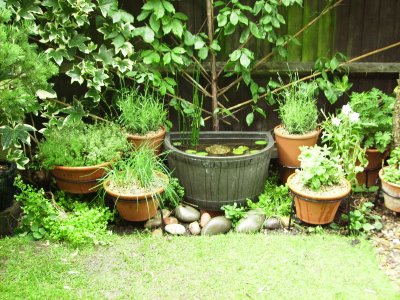A potted herb garden can be developed either indoors or outdoors. It is a popular way of growing herbs in the house, used for culinary and remedial preparations. Potted herb gardens are preferred over permanent, yard-based gardens since they are easy-to-maintain. With the use of containers for planting, moving around the plants becomes easier. Indoor, potted plants are also saved from the external pollutants. However, potted soil needs caring, as it doesn’t have the luxury of a large soil bed that stores nutrients or moisture. For starters, you should know which of the herbs grow well in a potted environment. The usual choices are basil, mint, sage, dill and lavender. Caring for your potted garden is not difficult but it does need some attention to detail and a systematic approach.
Container-based Herb Garden Care
The container or the pot that is use for growing herbs is parallel to the soil bed available to garden-grown plants. Please take care of the following:
Choice of Pots — It is crucial that you choose your pots carefully. Many retailed varieties are now available and some are suited for growing specific herbs only.
Pot Material — the material of the container should be matched with the spot chosen for placing them. For example, low-lying areas that are prone to water or moisture seepage shouldn’t be used for placing iron-made pots.
Drainage — the basic consideration while choosing herb pots is their draining ability. This is vital to ensure that the roots are not suffocated due to waterlogging. Check with the pot’s retailer about the draining ability of the drainage holes in the pot.
Pot Mobility — you should be aware of the amount of sunlight needed for the variety of herb planted. If this means moving the herb pots around the house, try to use pots made from lightweight, durable plastic. For ensuring that the pots are maneuverable, evaluate their weight/size at the time of purchasing.
Winter Pot Care — Some herbs need to be moved indoors for the entire duration of the winter season. This is particularly true for native tropical-climate herbs. They should be insulated indoors, in a warmer environment, created with plastic sheets and layers of newspapers spread on the ground.

Water-based Herb Garden Care
Most potted herb gardens have to be watered regularly, irrespective of the external climatic conditions, i.e. even in cold and wet climates. Please take care of the following:
Check Water Level — a common technique used to approximate the watering need is called the First Knuckle Test. To execute it, you need to press your index finger into the potted soil bed. If you can immediately feel moisture rising-up to the level of your knuckle, there is sufficient soil moisture. If not, you need to water it.
Spraying Water — in some potted herb gardens, spraying the stems and the foliage besides watering the pot is recommended. This is particularly applicable to potted herbs grown in extremely dry conditions.
Overwatering — while watering, if a small puddle begins to form, stop. This doesn’t necessarily mean that you have over-watered the pot. Wait for about four-to-five minutes. Chances are that the puddle dries-up itself — this happens because the top soil hasn’t been tilled.
Soil & Fertilization Requirements Include:
- Drainage — the potted soil should be fast draining. It is advised that the soil is enriched with organic food supplements like mulch or teaspoons of compost. This helps to add nutrition to the soil and improve its draining capabilities.
- Fertilization — potted herbs need constant addition of important nutrients. Always use potting soil mix for your potted herbs and not dug-up garden soil. Try to use organic plant food sources like peat, perlite and vermiculite rather than chemical fertilizers.
- Packed Soil — many varieties of packaged, pre-mixed (mixed with organic nutrients) potted soils are being retailed. These are preferred for indoor potted herbs as they are safe even if accidentally consumed by pets or children. Further, they have no chemicals that could be harmful, if the herbs are not properly washed when used in cooking.
Further Readings: